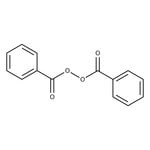Search Thermo Fisher Scientific
Thermo Scientific Chemicals
Dibenzoyl peroxide, 97% (dry wt.), wet with 25% water, Thermo Scientific Chemicals
Catalog number: L13174.0B
1000 g, Each



Thermo Scientific Chemicals
Dibenzoyl peroxide, 97% (dry wt.), wet with 25% water, Thermo Scientific Chemicals
Catalog number: L13174.0B
1000 g, Each
Quantity
Catalog number: L13174.0B
also known as L13174-0B
Price (USD)
Price: 137.00
Your price:
Quantity
-
Chemical Identifiers
CAS
94-36-0
IUPAC Name
benzoyl benzenecarboperoxoate
Molecular Formula
C14H10O4
InChI Key
OMPJBNCRMGITSC-UHFFFAOYSA-N
SMILES
O=C(OOC(=O)C1=CC=CC=C1)C1=CC=CC=C1
Specifications
Form
Wet powder or granules
Assay from Supplier's CofA
≥72 to ≤78%
Comment
Contact with metal may produce violent decomposition
Appearance (Color)
White
Description
Benzoyl peroxide is widely utilized as a radical initiator to induce polymerizations. It finds applications for acne treatment, for bleaching flour, hair and teeth and for cross-linking polyester resins. It also has major applications in antiseptic and bleaching properties. It serves as a catalyst for polyester thermoset resins and as a hardener to start the polymerization process.
This Thermo Scientific Chemicals brand product was originally part of the Alfa Aesar product portfolio. Some documentation and label information may refer to the legacy brand. The original Alfa Aesar product / item code or SKU reference has not changed as a part of the brand transition to Thermo Scientific Chemicals.
Applications
Benzoyl peroxide is widely utilized as a radical initiator to induce polymerizations. It finds applications for acne treatment, for bleaching flour, hair and teeth and for cross-linking polyester resins. It also has major applications in antiseptic and bleaching properties. It serves as a catalyst for polyester thermoset resins and as a hardener to start the polymerization process.
Solubility
Soluble in ether and chloroform. Slightlysoluble in ethanol. Insoluble in water.
Notes
Incompatible with strong oxidizer, reducing agents, acids, bases, alcohols and metals.
Benzoyl peroxide is widely utilized as a radical initiator to induce polymerizations. It finds applications for acne treatment, for bleaching flour, hair and teeth and for cross-linking polyester resins. It also has major applications in antiseptic and bleaching properties. It serves as a catalyst for polyester thermoset resins and as a hardener to start the polymerization process.
Solubility
Soluble in ether and chloroform. Slightlysoluble in ethanol. Insoluble in water.
Notes
Incompatible with strong oxidizer, reducing agents, acids, bases, alcohols and metals.
RUO – Research Use Only
Figures
Documents & Downloads
Certificates
Search by lot number or partial lot number
Frequently asked questions (FAQs)
Citations & References
Search citations by name, author, journal title or abstract text